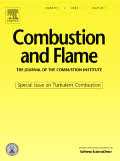
Due to the increasing interest in the use of biofuels for energy production, it is of great importance to better understand the combustion and thermal decomposition characteristics of species such as aldehydes. These are known to be key intermediate products of transport fossil and bio-fuels combustion and are also dangerous pollutants emitted from combustion in internal combustion engines and from gasification of biomasses. In this study, an experimental and kinetic modeling investigation of propanal, n-butanal and n-pentanal pyrolysis and oxidation in two shock tube facilities was carried out. Experiments were performed in a single pulse shock tube to determine the speciation profiles of the fuels and intermediate species under pyrolysis conditions for mixture of pure propanal/n-butanal/n-pentanal (3%)–Ar (97%), at averaged reflected pressure of 1.9 atm and at reflected shock temperatures of 972–1372 K. Additionally, ignition delay times for mixtures of pure propanal/n-butanal/n-pentanal (1%)–O2/Ar were measured in the temperature range 1136–1847 K, at pressures of 1 and 3 atm, and at equivalence ratios of 0.5, 1.0 and 2.0.
A comprehensive sub-mechanism for the high temperature kinetics of the three aldehydes was developed. This scheme was then coupled with NUIG (National University of Ireland, Galway) and POLIMI (Politecnico di Milano) C0single bondC4 kinetic schemes. The inclusion of the aldehydes sub-mechanism in two different kinetic environments, required modifications for the H-abstraction reactions, due to different rate rules in use in the two kinetic environments, and due to differences in the C0single bondC4 kinetic schemes. Both of the models were validated and showed good agreement with the new experimental data. The mechanisms are also satisfactorily compared with ignition delay times, speciation profiles and laminar burning velocities previously published in literature. Reaction pathways and sensitivity analyses were also performed to highlight the important reaction steps involved in the pyrolysis and oxidation processes. The major differences between the models and the experiments have to be attributed to the chemistry of the smaller species, more than to aldehyde specific reactions. This work further highlights the relevant role of the C0single bondC4 sub-mechanism, mainly in terms of a unification process that needs to start from the smaller species chemistry in order to obtain an unambiguous description of any fuel investigated.
Keywords
Aldehydes; Shock tube; Kinetic modeling; Ignition delay time; Pyrolysis
How to cite
Pelucchi, M., Somers, K.P., Yasunaga, K., Burke, U., Frassoldati, A., Ranzi, E., Curran, H.J., Faravelli, T.
An experimental and kinetic modeling study of the pyrolysis and oxidation of n-C3-C5 aldehydes in shock tubes
Combustion and Flame, 162 (2), pp. 265-286 (2015)









